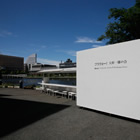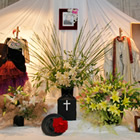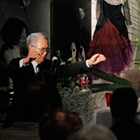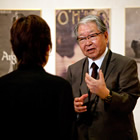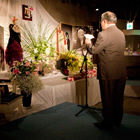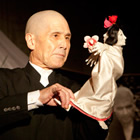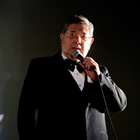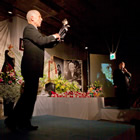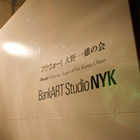We would like to express our heartfelt thanks to those who joined in the Bravo! A Joyous Send-off for Kazuo Ohno, as well as to those who wished to participate in it.
July 17, 2010
Bravo Kazuo Ohno steering committee
Kazuo Ohno: a Tribute
Eikoh Hosoe
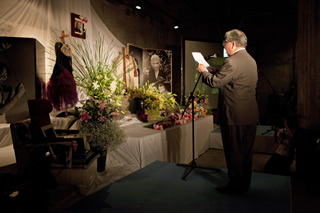
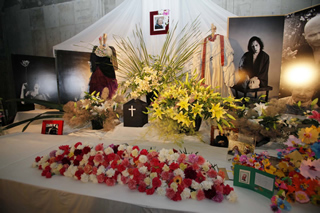
On the evening of June 1st 2010, I received a phone call from Yoshito Ohno
informing me of the sad news: “ This morning Kazuo Ohno’s condition took a
sudden change for the worse, and though hospitalised to undergo treatment,
he passed away peacefully at 4:38 pm.” At the time of his death, Ohno had lived
for 103 years and 7 months. Together with Tatsumi Hijikata, Ohno instigated
Butoh, an innovative form of artistic expression, of which he was the greatest
living exponent. So momentous were his achievements at the vanguard of the
movement that it is nigh on impossible to express the depth of sorrow and the
huge immensity of the loss that Ohno’s departure means to those of us following
in his wake.
That Kazuo Ohno remained actively immersed in Butoh for his entire lifetime
conveys to us the very essence of art. Moreover, Ohno-sensei constantly talked
about his ideas, and indeed was willing to set them forth with anybody, irrespective
of who they were.
All of our existences as human beings, in Ohno’s view, as well as our life force are due to DNA passed down over countless generations, covering a time span of tens and thousands of years. Thanks to the careful nurturing in his mother’s womb, Ohno was born into this world feeling secure in the knowledge of her love, while in the process inheriting her manifold joys and sorrows. According to Ohno, we both exist and are driven to survive thanks to the spirits within us. We owe our actual form to the countless blessings and ideas, experiences and learning passed on over time by our ancestors. Along with how to lead our lives, Butoh continually engages with these spirits and ideas within us; what we call ‘imagination’ arises out of the ensuing accumulation of conflicts. Ultimately, whether Butoh is powerful or not depends on how a dancer expresses this imagination through body language.
Ohno frequently discussed his creative output: “ Inevitably, one has to feel a spiritual dimension, a sense of prayer, rapture and the spirit vibrating for a work to constitute good art: What matters is whether it addresses our universal condition. In other words, Butoh both responds to and expresses our inner realities through physical expression. That means that it engages with the essence of human existence. In doing so, one could say that it ultimately renders love in its quintessential form. The idea of a dance unfolding like the birth of life has been my lifetime’s wish. I believe that even those bodiless spirits must express themselves by means of the human body.”
Given that from 1980 onwards Ohno began to receive numerous invitations to perform overseas, his creative output intensified. As is widely known, Ohno was received with critical acclaim wherever he performed. After initially coming to the attention of the dance world at the 14th International Theatre Festival in Nancy, at which his performance created shockwaves, invitations flooded in from all over the globe: He subsequently toured extensively in North and South America, throughout Europe and Asia, kindling excitement wherever he graced the stage. His performances were extolled everywhere, with some critics even going as far as to refer to them as a form of ‘radicalised expression.’ From among the many accolades Ohno received at that time, I would like to cite one particularly interesting commentary by the French dance critic, Dominique Fétard:
“ As Kazuo Ohno incarnates onstage the spirits of renowned artists, it is as though he is dancing on behalf of these departed. With Ohno as their conduit, these spirits of the dead living within him yearn to manifest themselves, to relate their life-stories. Ohno’s creations evoke the spirits of Claude Monet, or Divine, the male prostitute and protagonist in Jean Genet’s Our Lady of the Flowers. Thanks to Ohno’s scenic incarnation of La Argentina, the stage-name for the Spanish dancer Antonia Mercé — which he began performing in France and subsequently worldwide— her name emerged from oblivion.” To quote another passage:
“ Permeated by the spirits of Lautréamont and Baudelaire, Butoh is
influenced by the surrealists. Butoh dance is suggestive…….. As though a medium
falling under a spell, the Butoh dancer guides the audience towards unknown
worlds. While sometimes deeply moving, Butoh can soon become unbearable given
so much morbid violence. Drawn towards light,Kazuo Ohno gradually freed himself
from such a cauldron of emotions: instead he chose love as a source of inspiration.”
I would also like to briefly touch upon Ohno’s fortuitous meeting with Yutaka Haniya, well known as the leading exponent of Japanese literature. Until his dying days Haniya greatly encouraged him. In December 1995, the convalescing Haniya warmly greeted Ohno when he came to visit, and though bed-bound, he was still working on the 9th chapter of Shirei (Spirit of the Departed). The timing for this historic meeting between the Butoh maestro and the Japanese man of letters was truly remarkable in that Haniya, the writer, was at that very moment developing his cosmological theory based upon ‘the spirits of the dead’ and ‘the dream of the universe’ for the 9th chapter of his upcoming book, while Ohno, the dancer, was the very embodiment of the universe within a mother’s womb. After Ohno performed an improvised dance at his bedside, Haniya made an unforgettable comment: “Ohno-san, whenever you step out onstage, you lead us from one unknown place to another, you have taken the first steps towards a future where no-one has ever trodden before.”
Ohno-sensei, from where amongst the stars are you looking down upon us? Are you dreaming of a Butoh dance yet to be danced? We gather today here to express how deeply we miss you; to let you know in what high esteem we hold you. We will follow in your footsteps, ever willing to learn from and to listen to the wisdom of your words, and be touched by the poetic spirit emanating from a great teacher’s dance. Such is the way that you moved us that we are left overwhelmed.
Ohno-sensei, thank you for having guided us this far.
May you rest in eternal peace. And, please watch over us from the stars above.
July 19th, 2010
Eikoh Hosoe
Yoshito Ohno’s Closing Address at the Memorial Service.

I would like to thank to each and every one of you for having gathered here today to bid farewell to Kazuo Ohno. I truly appreciate this gesture on your part: despite your busy schedules and the mid-summer heat, you have joined us here for this memorial service. We are deeply grateful to all those whose help and assistance made Kazuo Ohno’s life what it was: one lived to the full, and one in which he was blessed with a natural death after a long life. Thanks to their unsparing efforts he is now on his way to heaven.
I myself can take heart from the fact that I had the good fortune to have
been guided on my way by Tatsumi Hijikata and Kazuo Ohno, and remain all the
more determined to face the future. For myself, for the Ohno family, and for
Butoh itself I would ask for your continued support. And let me reiterate our
deepest thanks to you all for having joined us here today.
Members of the Organising Committee:
- Spokesperson : Eikoh Hosoe
- Yoshito Ohno
- Yukito Nagatani
- Miki Wakamatsu
- Akira Kasai
- Akira Okamoto
- Mitsuyo Uesugi
- Yasuhiko Takeuchi
- Masahide Omori
- Kenzo Horikoshi
- Tomiko Takai
- Natsu Nakajima
- Naoya Ikegami
- Eiko & Koma
- Gara Motofuji
- Bera Motofuji
- Toshio Mizohata
- Catherine Diverres
- Kim Mae-ja ChangMu Dance Company
- Soshin Baptist School, Yokohama
- Kanto Gakuin, Yokohama
- Asahi Newspaper Group
- BankART 1929
- Teatro Editorial Department
- Shichosha Publishers
- Genndai Buyo Association
- Liaiosn of International Butoh
- Aichi Arts Center
- Film Art Publishers
- Kazuo Ohno Dance Studio
- Canta Co.Ltd
- Art Center, Keio University
- NPO Arts Network Japan
- Yuba Community Association, Brasil
- Kanamori Hall, Hakodate
- Kanagawa Arts Foundation
- Yokohama Arts Foundation
- Foundation for Culture and Sport Promotion in Hakodate
- Servicio Social de Comercio, Sao Paolo
- Kazuo Óhno Archives, Dept of Music and Performance, University
of Bologna



